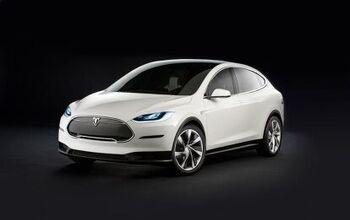TTAC: Ad Dendum
After more than two years of free content, The Truth About Cars is about to accept advertising– despite the publisher’s apprehension about advertising’s corrosive effect on editorial independence. It’s an understandable concern. Browse the auto "reviews" in your local daily newspaper. In the main, they consist of regurgitated press releases juxtaposed with stock photos, buried amongst dealer ads. The monthly automotive “buff books” claim they’re above such compromise. They maintain that they provide objective assessments of their test subjects. At the risk of throwing stones from a house about to add a greenhouse, can any publication that features more advertisements than content be objective?
Car and Driver, Road & Track, Automobile, Motor Trend and the rest of the magazines further down the car mag food chain are all supported by advertising. Unless a magazine is subsidized by a non-profit organization (e.g. Consumer Reports) or charges an exorbitant price per issue, it can’t survive without advertising. Few readers have problems with ads per se; they consider them wallpaper. But when the ads outweigh the content, questions begin to arise about who’s calling the editorial shots. Put a one or two-page ad for a new car in the middle of a glowing review of the same and those suspicions can easily turn to full-scale paranoia. Sneak in a multi-page "special advertising section" formatted to look and read like the rest of the magazine and credibility stretches to breaking point.
The stakes are certainly high enough to tempt an ad exec to mount an assault on his or her employer’s Chinese walls; advertising brings the buff books seriously big bucks. A full page ad in Car and Driver’s flimsy pages currently ranges from $102k to $157k. An inside or back cover will set a sponsor back between $182k and $198k. According to Folio magazine, Car and Driver raked in over $104m in ad revenue in the first half of ‘05, a figure that’s 26% higher than the same period in ‘04. The figures for the first half of 2006 will likely be even higher. With revenues like that, it’s no wonder the average automotive publication’s pages are dominated by advertising. Here are the stats for January–July 2006:
Motor Trend: 693.05 (99 ad pages/month)
Car and Driver: 622.20 (89 ad pages/month)
Road & Track: 622.18 (89 ad pages/month).
These three leading automotive publications average about 175 total pages per issue. And that means your favorite buff book is approximately 55% advertising. The remaining 45% includes photos, page headers, indices and lots of other things that an uncharitable reader might call filler. By the time you factor those items from the equation you’re lucky if 30% of the magazine is anything particularly useful. Does this unequal balance between editorial and advertising cause any uneasiness about editorial independence amongst the magazine’s publishers? Nope. Motor Trend’s publisher has publicly bragged about the fact that his publication has the highest advertising content in its market segment.
Less objectively, the bathroom has become a fitting location to peruse these publications, given the amount of crap they contain. I’ve read the magazines listed above since I was 12. I’ve watched them slide steadily into editorial abulia. While the ads have flourished like kudzu on horse manure, articles have become shorter and shallower (usually with more photos than text), and the road tests now read more like product endorsements than automotive reviews.
Perhaps it’s coincidental that this decline parallels the magazines’ increased ad revenues. Perhaps not. When you consider just how far down the slippery slope of compromise these publications have slid, you have to wonder what kind of incestuous relationships exists between the publishers and their ad agencies. Whether or not shady deals go down in ad execs’ cubicles, it’s clear that journalistic integrity isn’t their driving force any more.
The same disease has infected cyberland. While you expect auto magazines’ web sites to reflect their print counterpart’s pattern, many “independent” automotive sites are now dominated by advertising. Some of the ads are extremely clever/morally reprehensible: you think you’re getting objective information when you’re actually reading a page sponsored by a manufacturer. Only a handful of automotive web sites have the integrity to label ads clearly or reveal the perks they receive from the automakers whose products they’re reviewing.
TTAC publisher Robert Farago claims that the same editorial compromise will never occur here. To his credit (or discredit), Farago is a zealot who understands exactly what’s at stake. He’s publicly committed to maintaining this website’s editorial independence at all costs. Of course, the proof of the pudding is in the reading. Over the next few months you’ll be able to make your own determination: will TTAC keep its edge when it transforms from an amateur hobby to professional enterprise? Watch this space…
More by Frank Williams
Latest Car Reviews
Read moreLatest Product Reviews
Read moreRecent Comments
- Analoggrotto The ORDER BOOKS in Australia have netted 300% above projection. Australia is so awesome and they are embracing the Telluride DIesel to overtake the Prado. Pentagon data, and eATPs rule the discussion, bar none. Toyota fans can go home with their sorry little turbo 4 cylinder.
- Analoggrotto Such a loving artful tribute to TTAC's greatest godfather is much welcomed. There's a new and better PORSCHE and they are from SOUTH KOREA baby! After years of Japanese oppression, SOUTH KOREA is the TIGER of the Far EAST. We just need a modern day James Dean and that would be Rhys Millen!
- Groza George Our roads and bridges are crumbling and increasing vehicle weight will only make bridges crumble faster. We need more infrastructure work.
- Wolfwagen Pennsylvania - Two long straights, 1 medium straight, 1 super short straight and a bunch of curves all on one end
- Haze3 EV median weight is in the range of 4500-5500lbs, similar to the low end of full size pickup trucks and SUV's or typical mid-size PU's and SUV's. Obviously, EV Hummers and PU's are heavier but, on average, EV=PU or mid/full SUV is about right. EV's currently account for ~1% of the cars on the road. PU's account for 17% and SUV's count for over 40%. If we take out light SUV's, then call it 30% SUV or so. So, large-ish PU's and SUV's, together, account for ~50% of the US fleet vs 1% for EV's. As such, the fleet is ALREADY heavy. The problem is that EV's will be making the currently lighter 50% heavier, not that PU/SUV haven't already done most of the damage on avg mass.Sure, the issue is real but EV responsibility is not. If you want to get after heavies, that means getting after PU/SUV's (the current problem by 40-50x) first and foremost.


































Comments
Join the conversation
I'm seeing the ads now. Fairly unobtrusive, only slightly annoying due to animation. At least they're not flashing/"warning!" pop-ups. Hope this income helps the website move forward. You have my vote of confidence so far, Mr. Farago.
I'm Stephan Wilkinson's brother. If you want to know the model's name, email me. Oh, nuts, I was too young at the time to remember. Could we please lay off hybrid bashing? And global warming deniers? Puhleez. I own a Prius. I love cars. I had maybe the only M7 in the country (E23 chassis, Euro M6 engine and drivetrain, 750 brakes). It kept up with the Corvettes of the time on the track at Road America. It got 6 mpg on the track and 24 mpg on the highway. And I had several M3's, including a Dinan supercharged E36 M3 that was the best car I ever owned. Then I moved to the city. It's pointless to have a beautiful car in the city unless you shrink wrap it. So I bought a Prius. Hybrids are not a hoax. The damn thing gets 45 mph city/hwy with a leadfoot driver. It gets 24 mpg at a steady 100 mph (don't ask). It cruises comfortably at 80. The turn-in is terrible. Its lock-to-lock is twice that of the M3. The brakes are barely adequate (although they rarely get used because of flywheel braking). It will out-accelerate most consumer cars for the first 2 seconds (I do love drag-racing SUV's at the toll booths). The point is, the Prius is a flawless appliance. I took it in for its first service at 20,000 mi. (Yes, I know, I abuse the car. I don't care.) The car hadn't burned a drop of oil. The oil was still clear. The dealer charged me $175 for an oil change, a new air-conditioning filter, fluid check, and a tire rotation. That's the price of a wiper-blade change on a BMW. The Prius is the cheapest, most reliable non-car I've ever owned. Don't know if I'll buy a new one, though. They changed the design to make it look more like a Toyota and less like a refrigerator.